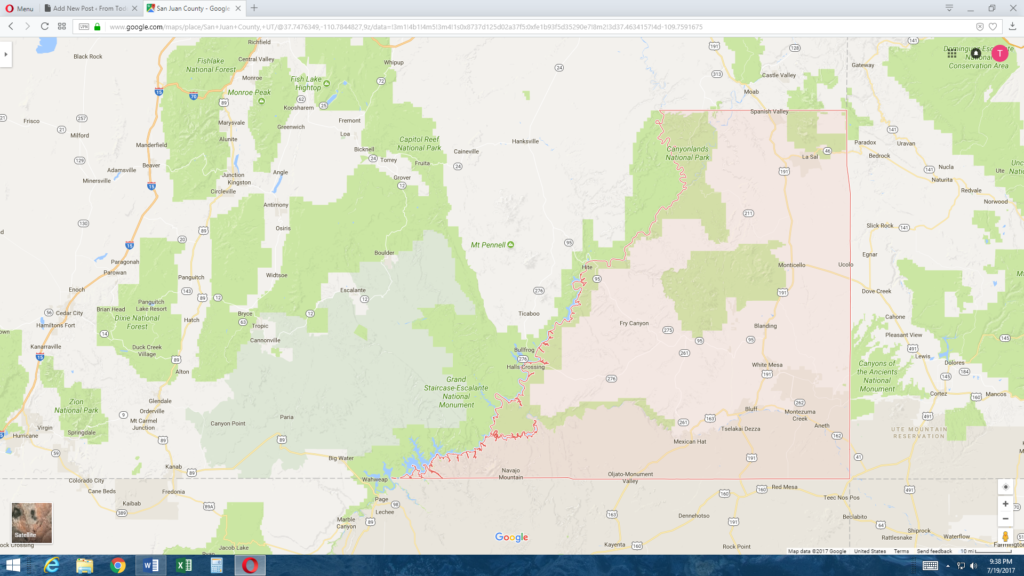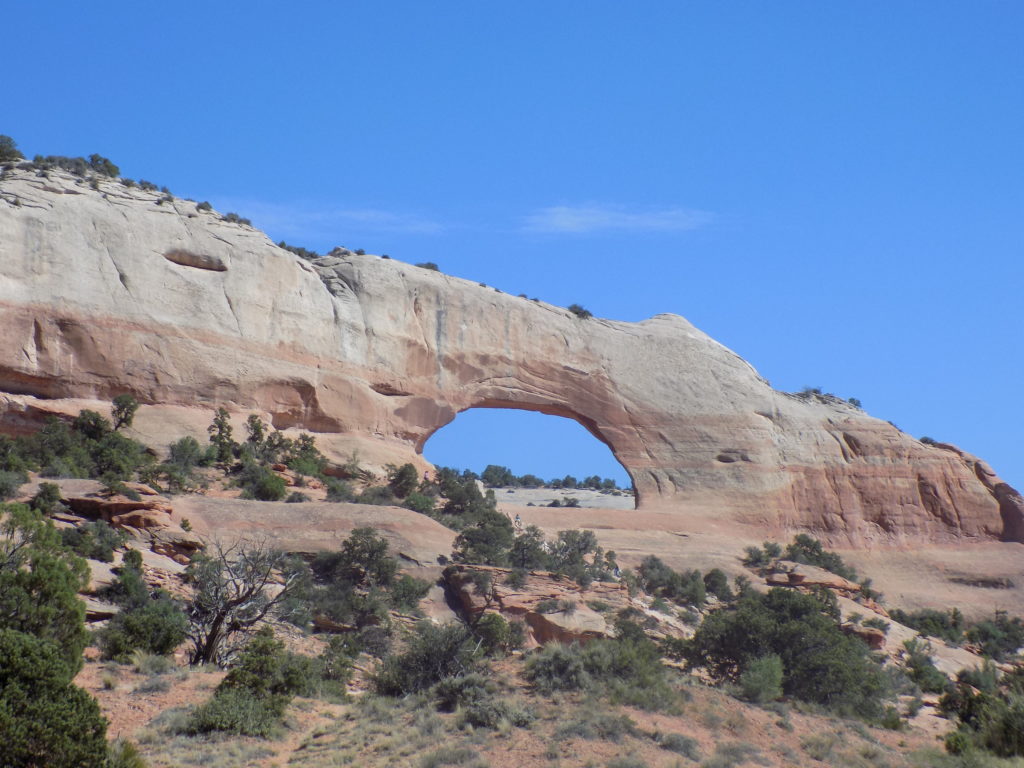Coincidental matters
Before I begin the main course of this final entry, I want to share a story that was published in the 1 August 2017 print edition of the Washington Post’s Health and Science section. The thrust of the story deals with the announcement by Ryan Zinke, the current Secretary of the Interior, to “dramatically scale down” the 1.35 million acres set aside in the waning days of the Obama administration to create the Bears Ears National Monument. The first two sentences read,
The route to Newspaper Rock — so named because it’s carved with ancient petroglyphs — from the tiny city of Monticello, Utah, follows a narrow two-lane road through a breathtaking landscape.
It’s breathtaking partly because of the way the land craters into canyons on stretches of State Road 211, causing uninitiated drivers to grip the steering wheel. Soon the earth rises into mountains that seem to glow red under the sun. On one short stretch, the mountains divide, giving way to the road.
The story is relatively short and has a lovely minute and a half video of other parts of the monument. For the price of your email address if you’re not a WAPO subscriber, you can read it here and if you’re interested in a more in depth look at the Trump administration’s proposals, my suggested starting point is this story in the Salt Lake Tribune. (The coincidence, for those who didn’t read the previous entry, is my decision not to visit Newspaper Rock.)
My final adventures
This isn’t the first time I’ve suggested you consult Google Maps to find a place I’ve visited. (Of course, you can use your map program of choice or even a paper map if that’s your preference.) This time, your search term should be Blanding, Utah or, better yet, San Juan County, Utah. If you scroll out to see the entire state, you might wonder why I’d choose to stay there. I’ll save you the trouble of taking that first step.
In truth, Blanding would be an excellent place to stay if you were interested in taking day trips to a remarkable collection of nearby locales. Here’s a list within Utah’s largest county by area (the Bears Ears National Monument as currently designated would claim nearly 27 percent of the county’s 7,820 square miles):
- Manti-La Sal National Forest – 32 miles
- Natural Bridges National Monument – 40 miles
- Newspaper Rock State Historical Monument – 47 miles
- Canyonlands National Park Needles District – 67 miles
- Oljato-Monument Valley – 70 Miles
- Canyonlands National Park Island District – 104 miles
- Dead Horse Point State Park – 104 miles
Leave the county by crossing into Grand County to the north or the state of New Mexico to the East and you can add:
- Canyons of the Ancients National Monument – 50 miles
- Four Corners National Monument – 70 miles
- Arches National Park – 80 miles
(And that big green area just to the north and west of Blanding on the map image above is the eerily named Dark Canyon Wilderness.) That’s a lot you can see within 105 miles and a two-hour drive. (Stretch out to 125 miles and you can add Canyon de Chelly to the list.)
Although I didn’t make the relatively short but quite vertical hike,
I stopped to take a photo of Wilson Arch some 25 or 30 miles south along the drive on U.S. 191 from Arches to Blanding. It’s an impressive natural sandstone arch that’s 46 feet high and spans 91 feet and is one more possible stop within 50 miles or so of the town.
But back to Blanding. Actually, I hope your first reaction when I mentioned I’d be staying in Blanding was, at the very least, “Where have I heard of that before?” Because, in fact, (although it won’t be on the final exam) in discussing the history of Monument Valley I noted that Blanding is the place where the final papers were signed ceding control of the valley to the Navajo in 1933. (Now your reaction should be, “Oh, that’s where I’ve heard of it.”)
I chose to stay in San Juan County’s most populous city (population 3,375 – nearly a quarter of the county’s residents) for a few reasons. First, I wanted to find a place close enough to Tucson that I could comfortably reach Sunday but not so far from the places I’d expected to visit on Saturday that I’d face a long drive at the end of a possibly tiring day while arriving, as is my preference, with at least some daylight remaining. Next, I knew from its website that Stone Lizard Lodging was locally owned and operated and, as I’ve stated elsewhere in this journal, I prefer supporting locally owned businesses. Blanding fit the bill on all counts.
Another point in Blanding’s favor was my belief that its location left me enough flexibility in time and distance that I could plausibly detour to at least one of three places I thought I might want to visit on my Sunday drive back to Tucson.
But there was still more about Blanding that influenced my choice to stay there. First, in my list of places to visit above, I didn’t include Edge of the Cedars State Park which is just outside the roughly two square miles of the city limits. The park earned its name because it occupies a natural boundary between the forest and desert. Unlike Dead Horse Point, which is a site for hiking and camping, this park is an archaeological site and museum occupying the grounds of an Ancestral Puebloan village. Its museum houses a large collection of Ancestral Puebloan pottery and relics.
Finally, there’s Blanding’s Dinosaur Museum that’s on the opposite side of town. The museum, run by spousal paleontologists Stephen and Sylvia Czerkas, is known for its focus on the relationship between dinosaurs and birds. In fact, a contributor to Roadside America described the museum this way, “Its topsy-turvy premise is that dinosaurs were not feathered reptiles that evolved into birds; they were giant feathered birds that lost the ability to fly.”
Now that I’ve finished my Chamber of Commerce pitch for Blanding, I’ll tell you that I visited neither of these places because I arrived Saturday evening and both are closed on Sunday. On the other hand, because I thought it might be a place you’d typically overlook it’s one I think you should consider visiting if you ever plan a trip to that area. (I’ll add that if you do visit and stay at Stone Lizard Lodging, and, like me, you’re a tea drinker, you should as I’ve discovered elsewhere in this part of the country, bring your own. They had not a single bag available.)
Note: In keeping with my 2022-2023 reformation of the blog into shorter entries, backdated to maintain their sequence, any comments on this post might pertain to its new configuration. See the explanation in the post Conventions and Conversions.


The Clifton gives me a whole new reason to revisit Tucson. That has to be at least one of the best key card/visitor info welcomes ever writ. LOL. The room looks pretty decent to me (love the wood ceiling) as well. Nice choice for your final night.
My brothers and I visited Tuscon for a few days some five years or so ago. We went partly to visit Kartchner Caverns State Park, about an hour or so south of Tucson. Their stalactites and stalagmites are said to rival those of Carlsbad, which I have ever seen. We had reservations made months in advance to get in. I think we stayed in some chain hotel where we found a suite that gave us a good rate, but not a downtown location. Been wanting to talk them into a revisit to the area and the Clifton sounds like a good location.
Make that “never” seen (Carlsbad). Would be nice to have an edit feature for our comments.
Well, I’ll have to ask the folks at BlueHost if there’s a way to do that.
Agree. The visitor info card was brilliant.